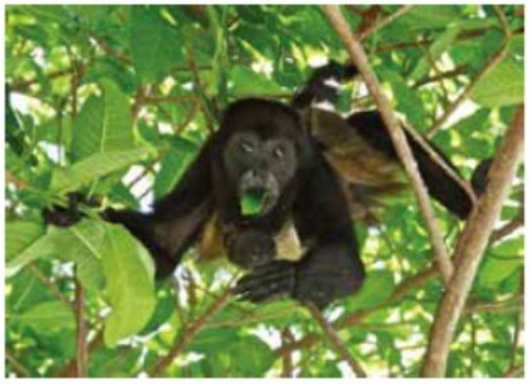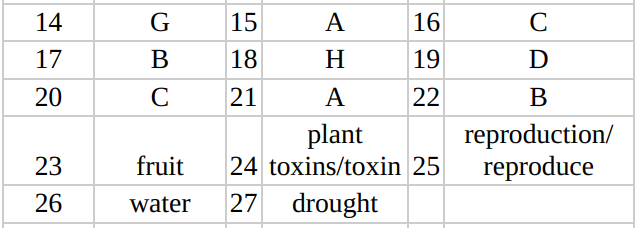Table of Contents
Passage
AS AN EAST WIND blasts through a gap in the Cordillera de Ti ỉ arán, a rugged mountain range that splits northern Costa Rica in half, a female mantled howler monkey moves through the swaying trees of the forest canopy.
A. Ken Glander, a primatologist from Duke University, gazes into the canopy, tracking the female’s movements. Holding a dart gun, he waits with infinite patience for the right moment to shoot. With great care, Glander aims and fires. Hit in the rump, the monkey wobbles. This howler belongs to a population that has lived for decades at Hacienda La Pacifica, a working cattle ranch in Guanacaste province. Other native primates — white-faced capuchin monkeys and spider monkeys — once were common in this area, too, but vanished after the Pan-American Highway was built nearby in the 1950s. Most of the smrounding land was clear-cut for pasture.

B. Howlers persist at La Pacifica, Glander explains, because they are leaf-eaters. They eat fruit, when it’s available but, unlike capuchin and spider monkeys, do not depend on large areas of fruiting trees. “Howlers can survive anyplace you have half a dozen trees, because theft eating habits are so flexible,” he says. In forests, life is an arms race between trees and the myriad creatures that feed on leaves. Plants have evolved a variety of chemical defenses, ranging from bad-tasting tannins, which bind with plantproduced nutrients, rendering them indigestible, to deadly poisons, such as alkaloids and cyanide.

C. All primates, including humans, have some ability to handle plant toxins. “We can detoxify a dangerous poison known as caffeine, which is deadly to a lot of animals” Glander says. For leaf-eaters, long term exposure to a specific plant toxin can increase their ability to defuse the poison and absorb the leaf nutrients. The leaves that grow in regenerating forests, like those at La Pacifica, are actually more howler friendly than those produced by the undisturbed, centuries-old trees that survive farther south, in the Amazon Basin. In younger forests, frees put most of their limited energy into growing wood, leaves and fruit, so they produce much lower levels of toxin than do wellestablished, old-growth trees.
D. The value of maturing forests to primates is a subject of study at Santa Rosa National Park, about 35 miles northwest of Hacienda La Pacifica. The park hosts populations not only of mantled howlers but also of white-faced capuchins and spider monkeys. Yet the forests there are young, most of them less than 50 years old. Capuchins were the first to begin using the reborn forests, when the trees were as young as 14 years. Howlers, larger and heavier than capuchins, need somewhat older trees, with limbs that can support their greater body weight.
A working ranch at Hacienda La Pacifica also explain their population boom in Santa Rosa. “Howlers are more resilient than capuchins and spider monkeys for several reasons,” Fedigan explains. “They can live within a small home range, as long as the trees have the right food for them, spider monkeys, on the other hand, occupy a huge home range, so they can’t make it in fragmented habitat.”
E. Howlers also reproduce faster than do other monkey species in the area. Capuchins don’t bear their first young until about 7 years old, and spider monkeys do so even later, but howlers give birth for the first time at about 3.5 years of age. Also, while a female spider monkey will have a baby about once every four years, well-fed howlers can produce an infant every two years.
F. The leaves howlers eat hold plenty of water, so the monkeys can survive away from open streams and water holes. This ability gives them a real advantage over capuchin and spider monkeys, which have suffered during the long, ongoing drought in Guanacaste.
G. Growing human population pressures in Central and South America have led to persistent destruction of forests. During the 1990s, about 1.1 million acres of Central American forest were felled yearly. Alejandro Estrada, an ecologist at Estacion de Biologia Los Tuxtlas in Veracruz, Mexico, has been exploring how monkeys survive in a landscape increasingly shaped by humans. He and his colleagues recently studied the ecology of a group of mantled howler monkeys that thrive in a habitat completely altered by humans: a cacao plantation in Tabasco, Mexico.
Like many varieties of coffee, cacao plants need shade to grow, so 40 years ago the landowners planted fig, monkey pod and other tall trees to form a protective canopy over their crop. The howlers moved in about 25 years ago after nearby forests were cut. This strange habitat, a hodgepodge of cultivated native and exotic plants, seems to support about as many monkeys as would a same-sized patch of wiki forest. The howlers eat the leaves and fruit of the shade trees, leaving the valuable cacao pods alone, so the farmers tolerate them.
H Estrada believes the monkeys bring underappreciated benefits to such farms, dispersing the seeds of fig and other shade frees and fertilizing the soil with feces. He points out that howler monkeys live in shade coffee and cacao plantations in Nicaragua and Costa Rica as well as in Mexico. Spider monkeys also forage in such plantations, though they need nearby areas of forest to survive in the long term.
He hopes that farmers will begin to see the advantages of associating with wild monkeys, which includes potential ecotourism projects. “Conservation is usually viewed as a conflict between agricultural practices and the need to preserve nature, Estrada says. “We’re moving away from that vision and beginning to consider ways in which agricultural activities may become a tool for the conservation of primates in human-modified landscapes.”
Questions
Questions 14-19
The reading Passage has seven paragraphs A-I.
Which paragraph contains the following information?
Write the correct letter A-I, in boxes 14-19 on your answer sheet.
14 a reference of reduction in Forest inhabitant
15 Only one species of monkey survived while other two species were vanished
16 a reason for howler Monkey of choosing new leaves
17 mention to howler Monkey’s nutrient and eating habits
18 a reference of asking farmers’ changing attitude toward wildlife
19 the advantage for howler Monkey’s flexibility living in a segmented habitat
Questions 20-22
Look at the following places and the list of descriptions below. Match each description with the correct place, A-E.
List of places
A Hacienda La Pacifica
B Santa Rosa National Park
C a cacao plantation in Tabasco, Mexico
D Estacion de Biotogia Los Tuxtlas in Veracruz, Mexico
E Amazon Basin
Write the correct letter, A-E, in boxes 20-22 on your answer sheet.
20 howler Monkey’s benefit to the focal region’s agriculture
21 Original home for all three native monkeys
22 A place where Capuchins monkey comes for a better habitat
Question 23-27
Complete the sentences below. Choose NO MORE THAN TWO WORDS from the passage or each answer.
Write your answer in boxes 23-27 on your answer sheet.
The reasons for Howlers monkey survive better in local region than other two species – Howlers in La Pacifica since they can feed themselves with leaf when 23…………..is not easily found – Howlers has better ability to alleviate the 24………….., which old and young trees used to protect themselves – when compared to that of spider monkeys and capuchin monkeys, the I 25………… rate of Howlers is relatively faster (round for just every 2 years) – the monkeys can survive away from open streams and water holes as the in Guanacaste leaves howlers eat hold high content of 26………….. which ensure them to resist to continuous 27…………. in Guanacaste.
Answers



